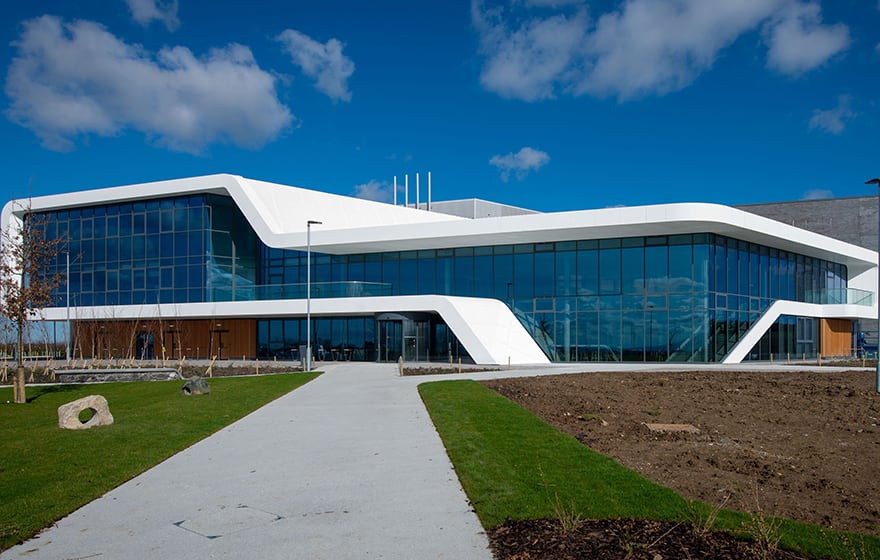Caulmert, a multi-disciplinary engineering consultancy with multiple offices across the UK and a base in St Asaph, North Wales, recently achieved the BRE Global Level 2 Business Systems Certification (now certified to PAS 1192-2:2013) and is making the transition to comply with the new international standard ISO 19650. It is one of fewer than 100 companies to achieve the global award. Here, David Murray, associate director, describes the firm’s BIM journey over the past five years.
Caulmert had aspirations to become certified when I joined the company in April 2015. The government mandate requiring BIM Level 2 on all centrally procured projects was yet to happen but BIM was already a hot topic. The UK was at the forefront of BIM in terms of knowledge and application, and construction companies across the UK were recruiting specialist BIM managers to develop and implement their BIM strategy.
This started at the top with the biggest main contractors and consultants the first to adopt BIM before it started to trickle down the supply chain. As a relatively young company, Caulmert was ambitious in its aspirations to be an early adopter and invested heavily in BIM. A central BIM team was created and infrastructure put in place so that BIM could be adopted company-wide
The now highly skilled team completed BIM Essentials, BIM Information Management, Clash Detection and Revit training. They were equipped with the latest AEC software and the best hardware (laptops and servers) which were powerful enough to run BIM applications quickly.
The next step was to implement the SMPs (standard methods and procedures) which are central to meeting BIM Level 2 requirements. This includes everything from BIM standards which explain the key principles and deliverables of a BIM project to our modelling methodology, which outlines how we deliver high quality models for design and analysis purposes. This process took some time to complete and the SMPs evolved as the industry adopted new technologies and methodologies. They were also continuously monitored to make sure they were fit for purpose.
With the people and infrastructure in place, Caulmert began working to BIM Level 2 standards, completing projects including Menai Science Park for WiIlmott Dixon and Ysgol Glancegin, Bangor for Wynne Construction. Earlier last year, we began the formal BIM assessment process with BRE who would assess our business capability in relation to:
- 3D modelling tools
- Standard systems & procedures
- Staff skills
- Business infrastructure
The first step was a pre-assessment in March last year which helped us to be “audit ready” by checking that we fully understood the requirements and had the correct documentation, systems, staff and procedures ready to be audited. After some minor modifications to procedures, the pre-assessment confirmed that we were in a good position to proceed.

Caulmert worked on Menai Science Park with Willmott Dixon (www.willmottdixon.co.uk)
This was worthwhile as it provided some assurance and prevented additional work during the audit. We were also pleased to receive positive feedback which put Caulmert in the top 20% of audits in terms of already complying to a BIM level 2 standard.
For the formal audit, we sent our SMPs and BIM-related documentation to BRE for a review and were visited by BRE for two days in September this year.
During the audit, BRE met with staff including our IT team and examined in great detail how we operate as a business, including:
- Staff training records and plans
- The application of a BIM execution plan
- Use of Task Information Delivery Plans (TIDP)
- BIM and CAD procedures
- Use of a common date environment
- Clash avoidance procedures
The audit was an interesting but intense process during which everything we had put in place was scrutinised, and after the audit came the wait! Seven weeks after the audit we were informed that we had been successful and would be awarded the BRE Global Level 2 Business Systems Certification. The team was understandably delighted to achieve this.
Whilst we have been working within the principles of BIM for a significant time, this award is really important to us. It cements our place as one of relatively few UK businesses who can truly demonstrate full BIM capability and will give our public sector clients the assurances they need. It also demonstrates our ambition and we believe it will attract dynamic talented staff who are looking for an innovative employer.
Now we have been certified in accordance with the requirements of PAS 1192-2:2013, Caulmert is making the transition to comply with the new international standard ISO 19650.
The journey to BIM Level 2 has been smooth but it did require significant time and financial investment. It’s great to see our collective hard work pay off and we think the pay off will continue as our certification opens up new doors.
Caulmert was set up in 2009 and turns over around £3.3m across a broad range of engineering, environmental, planning and local authority-related services. Its 54 staff work at the St Asaphs headquarters and in five offices across the UK.
Caulmert’s main software supplier is Autodesk, utilising the AEC Collection suite. This year’s ambitions include moves into laser scanning and drone surveying.











